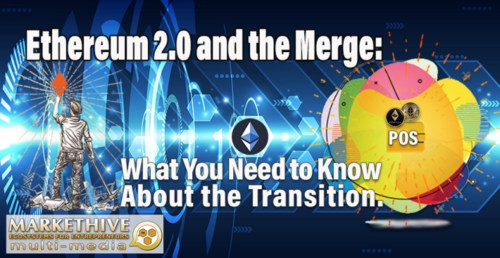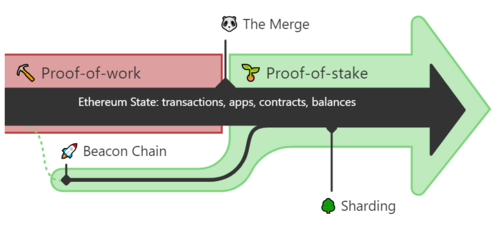
Ethereum 2.0 and the Merge: What You Need to Know About the Transition.

The Ethereum Merge has been one of the hottest topics in the cryptocurrency community lately. In this article, you will get to know about it and when Ethereum 2.0 will appear. Ethereum, the most popular altcoin and second most traded cryptocurrency, is planning a major software update that could affect your crypto investments.
After years of being the #1 smart contract blockchain, Ethereum is transitioning to a less energy-intensive technology. You may have heard of the planned update for Ethereum 2.0 or Eth 2.0, but the Ethereum Foundation is now calling it the Ethereum merger.
The move is expected to reduce Ethereum's power consumption by 99% while reducing the net issuance of the asset. Many expect the issuance of ETH to be a net negative, earning it the nickname "ultrasound currency."
The following focuses on the details of the merger, some brief technical details, and a timeline, and debunks some of the most common misconceptions.
What is The Merge?
As mentioned above, "The Merge" describes Ethereum's transition from a proof-of-work consensus algorithm to a proof-of-stake algorithm.
Ethereum gives a precise definition of the term here:
"The Merge represents the joining of the existing execution layer of Ethereum (the mainnet we use today) with its new proof-of-stake consensus layer – the Beacon Chain."

Source: Ethereum.org
This is to handle the energy-intensive mining process while securing the network with staked ETH. The move aims to ensure greater security, sustainability, and scalability for the Ethereum network.
Let's dig deeper into the technical aspects for greater clarity and understanding.
Beacon Chain: ETH 2.0 Processing Engine
The Beacon Chain is the important feature of the Ethereum 2.0 architecture. It exists and operates in parallel as an independent blockchain of the Ethereum network. It does not process transactions on the main network but achieves consensus on its own. This is done by agreeing on active checkers and their account balances.
Unlike the Ethereum network, which still operates through proof-of-work, the signal chain is powered by a consensus algorithm. It was developed on December 1, 2020.
In short, the Beacon Chain has so far served as the de facto testnet for Ethereum 2.0, but all of this will change with the merger.
As shown in the diagram above, the merger represents the moment when two systems (Ethereum mainnet currently running on PoW and the beacon chain running on PoS) come together. This merge will replace the PoW consensus algorithm with Proof-of-Stake (PoS).
This holds up some substantial implications for the network, but the crucial considerations include:
- No history will be lost
- Funds are safe
- No more mining of ETH
When Will the Merge Happen?
It's worth noting that Ethereum 2.0 has been in development for years, and the exact date of the "merger" always looks like something might happen in the not-too-distant future.
All of the delays ended on July 14, 2022, when a member of the Ethereum Foundation shared a timeline showing what came to be known as a "soft" timetable for the merger.
The Superphiz timeline shared on Twitter includes a specific client release date and the so-called The Merge date. Despite the date, Superphiz also stated that "this merger timeline is not final," The developer stressed that people should "consider it as a planning timeline, and keep an eye out for any official announcements. The call, titled "PoS Implementers' Conference Call" Document #91 – 2022-07-14" states that the "proposed" timeline for discussion is as follows:
- Goerli/Prater client releases 27th or 28th of July.
- Announce 28th/29th.
- Prater Bellatrix on the 8th of August
- Goerli Merge on the 11th.
- ACD 18th August plan mainnet Merge:
- Bellatrix early September;
- Merge two weeks later (week of Sept 19th).
As shown above, the merger is scheduled to take place on September 19, 2022, barring unforeseen events, including "the Goerli merger won't blow up." That date is not set in stone, though; delays may occur if complications arise.
Get Ready for The Merge?
This is one of the most significant events in the entire history of the cryptocurrency industry, so many bad actors will likely try to take advantage of it and scam innocent people.
Hence, it is essential to know that ETH users and holders do not need to do anything with their funds or wallets before merging.
The entire history of Ethereum – dating back to its creation, will remain unchanged and intact after the transition to PoS. Even after the merger, all funds in the wallet will still be accessible, and there is no need to upgrade on behalf of users and holders.
Moreover, as part of the preparation for regular traders, it’s imperative to know that you are not expected to take any action for the upgrade. Beware of scammers who would want to rip you off your coins.
Ethereum Network After the Merge
One of the major promises of Ethereum 2.0 is that of scalability, and Vitalik Buterin claimed that the network would be able to process 100,000 transactions per second. However, The Merge is just the first stage of five from the protocol’s incoming development. These phases will see ETH 2.0 evolve into a full-fledged platform capable of handling millions of daily users.
It means there will be many more potential uses for the cryptocurrency than just smart contracts, like an app store or even gambling sites. If the Ethereum developers want ETH 2.0 to become one of the significant blockchains used worldwide, they need to ensure that the tech is scalable enough to handle all the projects on their roadmap.
The five developmental stages are as follows:
The Merge
This is the proof-of-work to proof-of-stake conversion discussed hereafter, merging Ethereum's current mainnet with the beacon chain.
The Surge
At this stage, this is what sharding brings to the protocol. A scaling solution divides the network into separate partitions called "shards" to spread workloads across the main network.
The Verge
This phase refers to the introduction of the so-called "Verkle tree." It includes an upgrade to Merkle Proofs designed to optimize data storage for Ethereum nodes.
The Purge
Also, this upgrade affects validator data storage and reduces the disk space required by validators, optimizing network congestion.
The Splurge
This is the last upgrade in the pipeline and is intended to provide various progress updates to ensure the network's overall smooth operation.
Misconceptions About the ETH 2.0
As with all highly anticipated major events, the cryptocurrency community has had many common misconceptions floating around for some time now. Below are five of the most common.
It needs to stake 32 ETH to run a node
There are two kinds of nodes on the Ethereum network – the ones that can propose blocks and those that cannot. Those not required to commit ETH do not propose blocks, but they are also an integral part of network security, as they hold all block proposers accountable.
Gas fees will be reduced after the merger
The merger will change the general consensus algorithm and will not increase network capacity – and, therefore, will not result in lower gas tariffs. However, scaling solutions are being developed to do this, most of which are layer 2.
Transaction speed will be greatly improved
Transaction speeds on the merged mainnet will remain relatively unchanged, albeit with some minor changes.
Consolidation will cause downtime for the entire network
Merge upgrades are designed to avoid downtime. The network should always behave as expected except for minor issues, which are usual with software installation.
All staked ETH will be withdrawn after the transition
Validators leaving the network are rate limited. This is for security reasons. There is a limit to allow withdrawals of around 43,200 ETH per day. As of this writing, more than 13 million ETH has been staked in ETH 2.0.
Summary
All in all, The Merge is undoubtedly one of the most important moments in the history of cryptocurrencies, as one of the greatest protocols is about to undergo a huge change. Now that the timetable is in place, all of this has been tightened considerably, albeit "softly." However, there are still many details we don't know yet, and no doubt they will be revealed in due course, so it's best not to get too excited or nervous yet.

Tim Moseley

